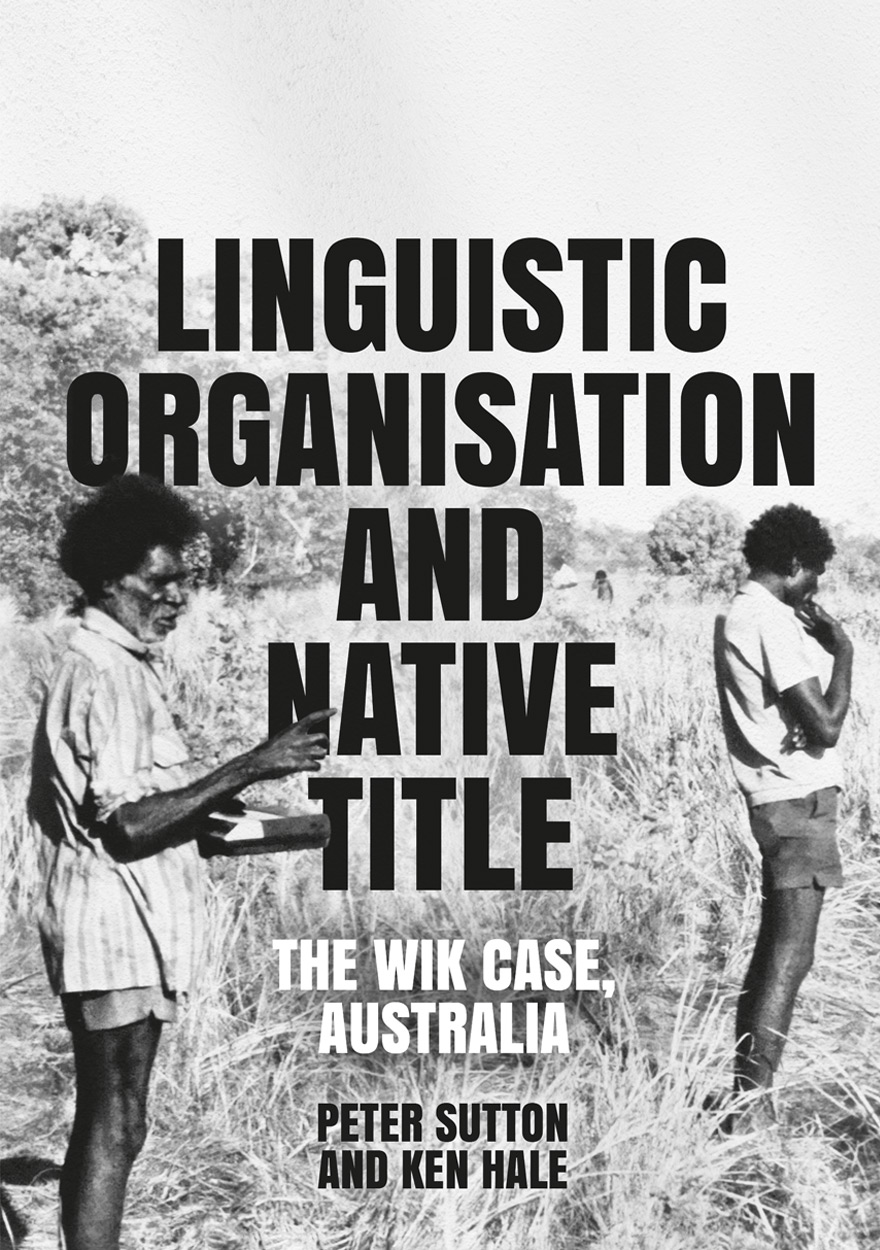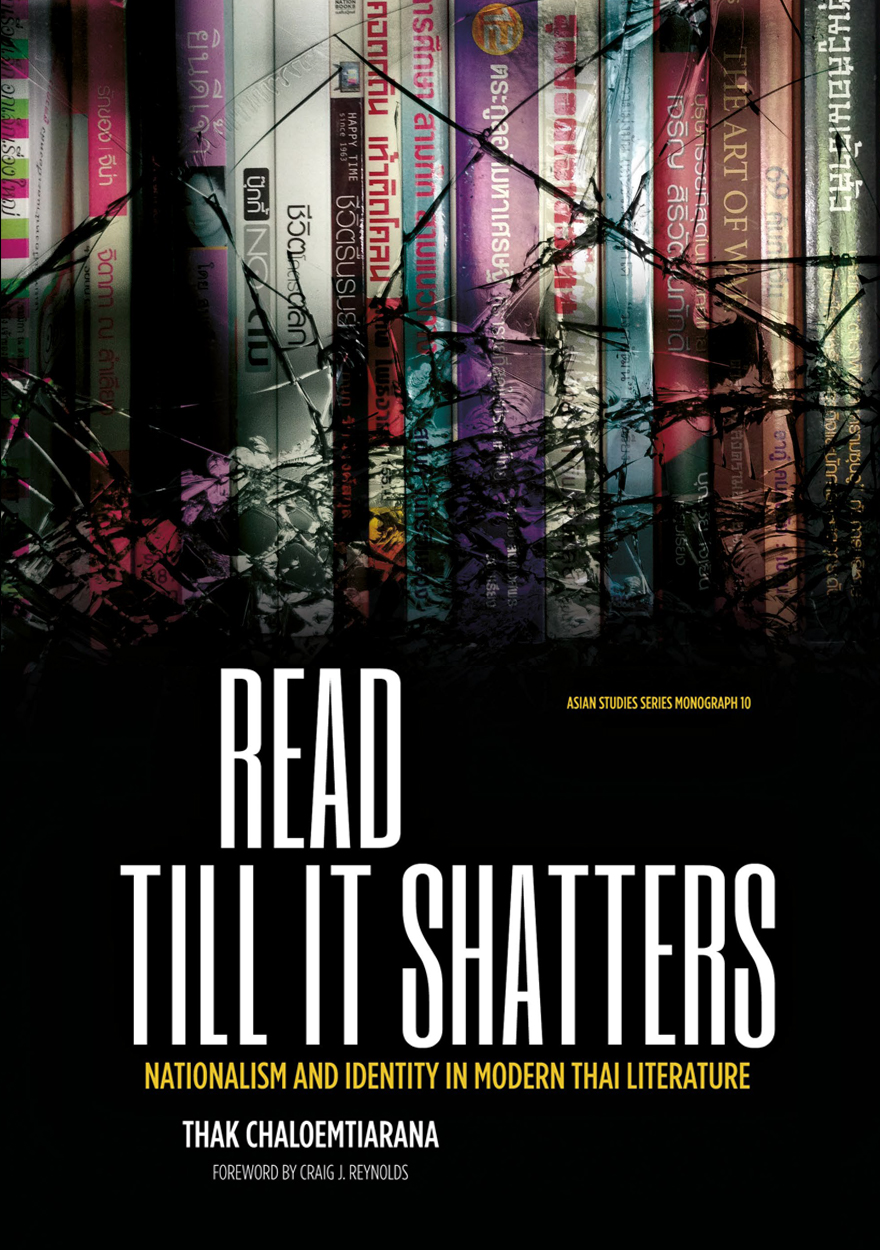Search titles
Displaying results 11 to 20 of 37.

Linguistic Organisation and Native Title »
The Wik Case, Australia
Authored by: Peter Sutton, Kenneth Locke Hale
Publication date: September 2021
Classical Aboriginal societies in Australia have commonly been described in terms of social organisation and local organisation. This book presents rich detail on a third and related domain that has not been given the same kind of attention: linguistic organisation.
Basing their analyses on fieldwork among the Wik peoples of Cape York Peninsula, north Australia, Peter Sutton and Ken Hale show how cosmology, linguistic variation, language prehistory, clan totemic identities, geopolitics, land use and land ownership created a vibrant linguistic organisation in a classical Aboriginal society.
This has been a society long in love with language and languages. Its people have richly imbued the domain of rights and interests in country—the foundations of their native title as recognised in Australian law—with rights and interests in the abundance of languages and dialects given to them at the start of the world.

Intermediate Ancient Greek Language »
Authored by: Darryl Palmer
Publication date: March 2021
Intermediate Ancient Greek Language is a series of Lessons and Exercises intended for students who have already covered most of an introductory course in the ancient Greek language. It aims to broaden and deepen students’ understanding of the main grammatical constructions of Greek. Further attention is given to grammatical forms to illustrate their functions.
In the Lessons, tragedy, comedy, historiography, oratory and philosophy are sources for dramatic material. The Cases have been deliberately placed late in the series of Lessons 36 to 41; students by now will be prepared to analyse Case usage. Consideration of prepositions in Lesson 42 naturally follows the Cases. Lesson 43, on correlative clauses, links with adjectival and adverbial constructions in previous Lessons. The final Lesson 44 deals with exclamations.
Throughout the book, the author relies on genuine Greek sources for the passages in the Lessons and Exercises.

Meaning, Life and Culture »
In conversation with Anna Wierzbicka
Edited by: Helen Bromhead, Zhengdao Ye
Publication date: December 2020
This book is dedicated to Anna Wierzbicka, one of the most influential and innovative linguists of her generation. Her work spans a number of disciplines, including anthropology, cultural psychology, cognitive science, philosophy and religious studies, as well as her home base of linguistics. She is best known for the Natural Semantic Metalanguage (NSM) approach to meaning—a versatile tool for exploring ‘big questions’ concerning the diversity and universals of people’s experience in the world.
In this volume, Anna Wierzbicka’s former students, old and current colleagues, ‘kindred spirits’ and ‘sparring partners’ engage with her ideas and diverse body of work. These authors cover topics from the grammar of action verbs to cross-cultural pragmatics, and over 30 languages from around the world are represented.
The chapters in Part 1 focus on the NSM approach and cover four themes: lexico-grammatical semantics, cultural keywords, semantics of nouns, and emotion. In Part 2, the contributors connect with a meaning-based approach from their own intellectual perspectives, including syntax, anthropology, cognitive linguistics and sociolinguistics.
The deep humanistic perspective, wide-ranging themes and interdisciplinary nature of Wierzbicka’s research are reflected in the contributions. The common thread running through all chapters is the primacy of meaning to the understanding of language and culture.

A Linguistic History of Italy »
Storia Linguistica d'Italia
Authored by: John J Kinder, Grazia Scotellaro
Publication date: September 2020
Italy has a long and fascinating history that has been recorded since the earliest days of Rome itself: we know how politics, ideas, culture, art, architecture, music and much more, have developed over nearly three millennia. At the heart of the life of the peoples of the Italian peninsula and islands is their language. A Linguistic History of Italy tells the story of how the language spoken in Italy developed from Latin to multiple dialects, to the selection of Florentine for a national written language and how Italian became the common language of the entire nation. At each step on this amazing journey language intertwines with other components of Italian social life.
The chapters of A Linguistic History of Italy take you through the history of Italian society, art, ideas and language. The chapters focus on the turning points in language history – when Latin ‘became’ Romance, when local dialects were first used in writing, when Florentine was selected as the national language for literature, when Italian became the ‘national language’ – and show how those moments only fully make sense when seen in a broader context.
The text is written in both English and Italian, so you can improve your linguistic skills while immersing yourself in Italian culture. And the many images give a visual feast of Italian beauty through the centuries.
Not available for purchase

A Sketch Grammar of Pondi »
Authored by: Russell Barlow
Publication date: July 2020
This book provides the first grammatical description of Pondi, a severely endangered language spoken by fewer than 300 people, almost all of whom live in a single village in the East Sepik Province of Papua New Guinea. Pondi is a non-Austronesian (i.e. Papuan) language, belonging to the Ulmapo branch of the Keram family. A Sketch Grammar of Pondi includes ethnographic information, with ample discussion of language vitality and endangerment. The grammatical description begins with phonetics and phonology, before turning to major and minor word classes. The description of nominal morphology focuses especially on Pondi’s irregular number affixation and stem alternation, while the description of verbal morphology is largely concerned with aspect and mood suffixation. Syntax is discussed both at the level of the phrase and at the level of the clause. Topics in syntax, such as questions, commands, negation and conditionals are discussed. Following the grammatical description, there is a lexicon of over 600 Pondi words, presented both as a Pondi-to-English word list and as an English-to-Pondi finder list.

Read till it shatters »
Nationalism and identity in modern Thai literature
Authored by: Thak Chaloemtiarana
Publication date: August 2018
This book introduces readers to modern Thai literature through the themes of modernity, nationalism, identity and gender. In the cultural, political and social transformations that occurred in Thailand during the first half of the twentieth century, Thai literature was one of the vehicles that moved the changes. Taking seriously ‘read till it shatters’, a Thai phrase that instructs readers to take apart the text, to break it down, to deconstruct it, Thak Chaloemtiarana challenges the Thai literary canon from the margins and suggests ways of expanding and enriching it.
Thai literature is scarce in translation and requires the skills of a scholar fluent in Thai to comprehend it. Thak is a political scientist turned literary scholar who is bilingual in Thai and English and an avid reader of Thai fiction by authors up and down the social scale. Here he offers lively insights into his favourite literary genres with fresh readings of early Thai novels, Sino-Thai biographies and memoirs of the rich and famous.
‘Thak Chaloemtiarana is an inquisitive man. Late in his career he switched from politics to literature. In these chapters, he draws on a lifetime of reading about writers and writing in Thailand over the past century. He nods towards the usual big names—King Vajiravudh, Luang Wichit, Kulap Saipradit, Kukrit Pramoj—but spends more time on those found in the lesser visited stacks of the libraries, the secondhand bookstalls, and the shelf by the supermarket checkout. His themes are familiar—Thailand and the West, Thai nationalism, the Thai-Chinese, and women under patriarchy—but the angles of vision are original. With a cast ranging from motor-racing princes through sexy Egyptian mummies and a feminist serial murderer to starlets touting breast-enhancement techniques, this book educates, enlightens, and entertains.’
— Dr Chris Baker, Bangkok-based author with Pasuk Phongpaichit, A History of Ayutthaya (Cambridge 2017)

Carl Strehlow’s 1909 Comparative Heritage Dictionary »
An Aranda, German, Loritja and Dieri to English Dictionary with Introductory Essays
Edited by: Anna Kenny
Publication date: August 2018
Carl Strehlow’s comparative dictionary manuscript is a unique item of Australian cultural heritage; it is a large collection of circa 7,600 Aranda, 6,800 Loritja (Luritja) and 1,200 Dieri to German entries compiled at the beginning of the twentieth century at the Hermannsburg Mission in central Australia. It is an integral part of Strehlow’s ethnographic work on Aboriginal cultures that his German editor Baron Moritz von Leonhardi published as Die Aranda- und Loritja-Stämme in Zentral-Australien (Strehlow 1907–1920) in Frankfurt. Strehlow and his editor had planned to publish a language study that included this comparative dictionary, but it remained unpublished until now due to a number of complicated historical and personal circumstances of the main characters involved with the dictionary.
Strehlow’s linguistic work is historically and anthropologically significant because it probably represents the largest and most comprehensive wordlist of Indigenous languages compiled in Australia during the early stages of contact. It is an important primary source for Luritja and Aranda speakers. Both languages are spoken in homes and taught in schools in central Australia.
The reasons for presenting this work as a heritage dictionary—that is, as an exact transcription of the original form of the handwritten manuscript—are to follow the Western Aranda people’s wishes and to maintain its historical authenticity, which will prove to be of great use to both Indigenous people and scholars interested in language.

German Ethnography in Australia »
Edited by: Nicolas Peterson, Anna Kenny
Publication date: September 2017
The contribution of German ethnography to Australian anthropological scholarship on Aboriginal societies and cultures has been limited, primarily because few people working in the field read German. But it has also been neglected because its humanistic concerns with language, religion and mythology contrasted with the mainstream British social anthropological tradition that prevailed in Australia until the late 1960s. The advent of native title claims, which require drawing on the earliest ethnography for any area, together with an increase in research on rock art of the Kimberley region, has stimulated interest in this German ethnography, as have some recent book translations. Even so, several major bodies of ethnography, such as the 13 volumes on the cultures of northeastern South Australia and the seven volumes on the Aranda of the Alice Springs region, remain inaccessible, along with many ethnographically rich articles and reports in mission archives. In 18 chapters, this book introduces and reviews the significance of this neglected work, much of it by missionaries who first wrote on Australian Aboriginal cultures in the 1840s. Almost all of these German speakers, in particular the missionaries, learnt an Aboriginal language in order to be able to document religious beliefs, mythology and songs as a first step to conversion. As a result, they produced an enormously valuable body of work that will greatly enrich regional ethnographies.

Tides of Innovation in Oceania »
Value, materiality and place
Edited by: Elisabetta Gnecchi-Ruscone, Anna Paini
Publication date: April 2017
Tides of Innovation in Oceania is directly inspired by Epeli Hau‘ofa’s vision of the Pacific as a ‘Sea of Islands’; the image of tides recalls the cyclical movement of waves, with its unpredictable consequences. The authors propose tides of innovation as a fluid concept, unbound and open to many directions. This perspective is explored through ethnographic case studies centred on deeply elaborated analyses of locally inflected agencies involved in different transforming contexts. Three interwoven themes—value, materiality and place—provide a common thread.

New Perspectives in Southeast Asian and Pacific Prehistory »
Publication date: March 2017
‘This volume brings together a diversity of international scholars, unified in the theme of expanding scientific knowledge about humanity’s past in the Asia-Pacific region. The contents in total encompass a deep time range, concerning the origins and dispersals of anatomically modern humans, the lifestyles of Pleistocene and early Holocene Palaeolithic hunter-gatherers, the emergence of Neolithic farming communities, and the development of Iron Age societies. These core enduring issues continue to be explored throughout the vast region covered here, accordingly with a richness of results as shown by the authors.
Befitting of the grand scope of this volume, the individual contributions articulate perspectives from multiple study areas and lines of evidence. Many of the chapters showcase new primary field data from archaeological sites in Southeast Asia. Equally important, other chapters provide updated regional summaries of research in archaeology, linguistics, and human biology from East Asia through to the Western Pacific.’
Mike T. Carson
Associate Professor of Archaeology
Micronesian Area Research Center
University of Guam



